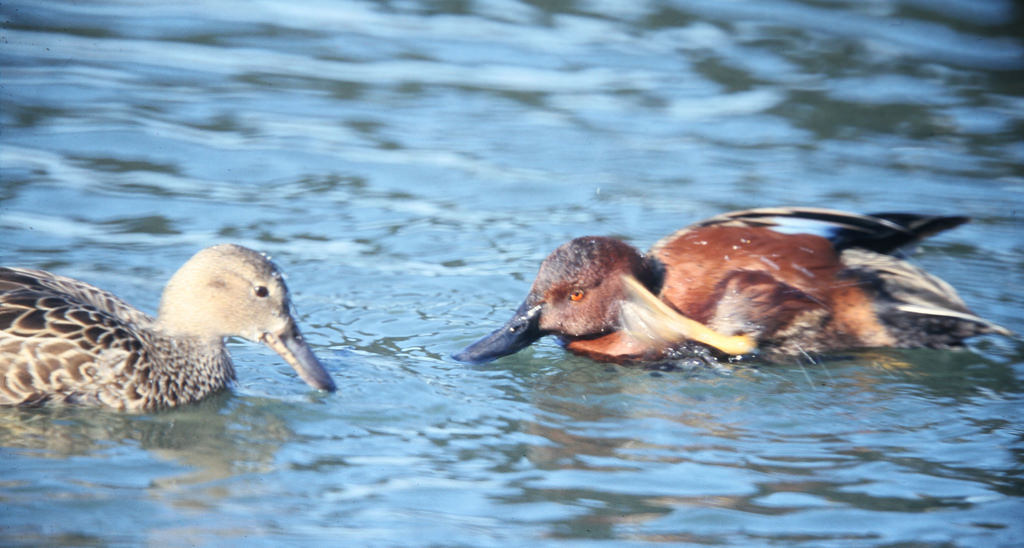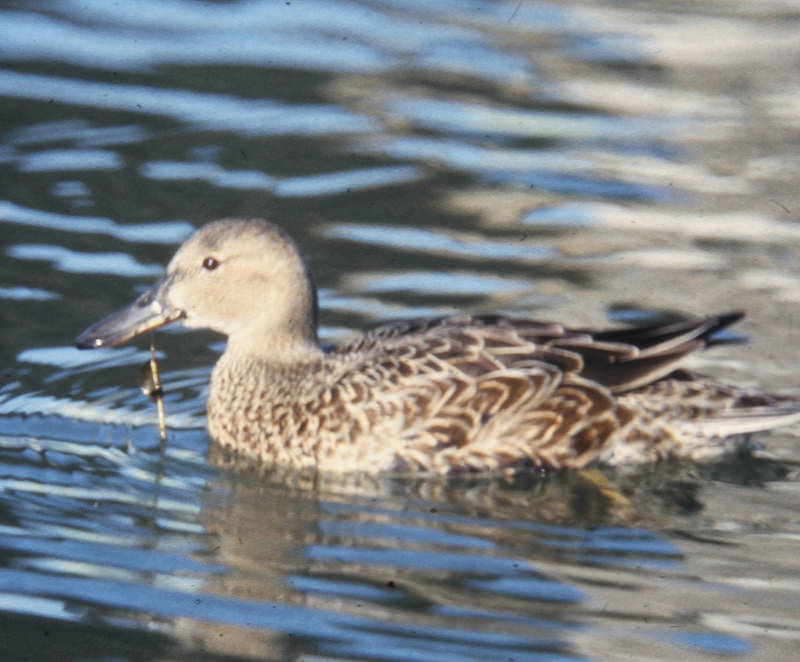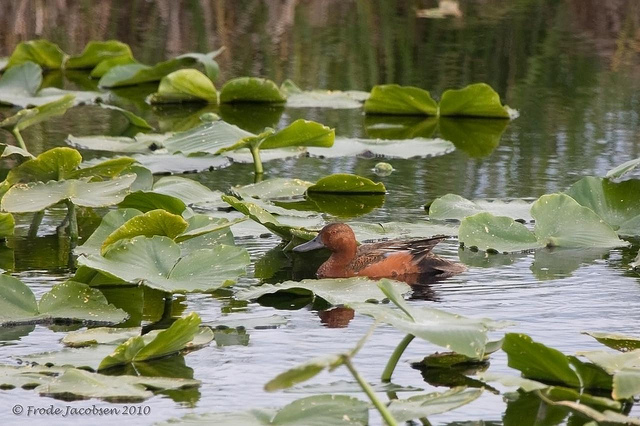Map Snapshot



5 Records
Status
There are two accepted records of Cinnamon Teal for Maryland. The first record is from November 1987 in Queen Anne's County. The last record is from Eastern Neck NWR in Kent County in November and December 2008.
Seasonality Snapshot
Source: Wikipedia
| Cinnamon teal | |
|---|---|

| |
| Spatula cyanoptera (male) | |
| Scientific classification | |
| Domain: | Eukaryota |
| Kingdom: | Animalia |
| Phylum: | Chordata |
| Class: | Aves |
| Order: | Anseriformes |
| Family: | Anatidae |
| Genus: | Spatula |
| Species: | S. cyanoptera
|
| Binomial name | |
| Spatula cyanoptera (Vieillot, 1816)
| |
| Subspecies | |
|
4 living, 1 possibly extinct; see text | |

| |
Breeding Migration Year-round Nonbreeding
| |
| Synonyms | |
|
Anas cyanoptera Vieillot, 1816 | |
The cinnamon teal (Spatula cyanoptera) is a species of duck found in western North and South America. It is a small dabbling duck, with bright reddish plumage on the male and duller brown plumage on the female. It lives in marshes and ponds, and feeds mostly on plants.
Description
[edit]The adult male has a cinnamon-red head and body with a brown back, a red eye and a dark bill. The adult female has a mottled brown body, a pale brown head, brown eyes and a grey bill and is very similar in appearance to a female blue-winged teal; however, its overall color is richer, the lores, eye line, and eye ring are less distinct. Its bill is longer and more spatulate. Male juvenile resembles a female cinnamon or blue-winged teal but their eyes are red.[2][3] They are 16 in (41 cm) long, have a 22-inch (560 mm) wingspan, and weigh 14 oz (400 g).[3] They have 2 adult molts per year and a third molt in their first year.[3]
-
Female Spatula cyanoptera septentrionalium
-
Male (left) and female
-
Male
Distribution
[edit]Their breeding habitat is marshes and ponds in western United States and extreme southwestern Canada, and are rare visitors to the east coast of the United States.[3] One young male duck was spotted in Grimsby, Ontario, and became a tourist attraction due to its rarity outside of western Canada.[4] Cinnamon teal generally select new mates each year. They are migratory and most winter in northern South America and the Caribbean,[5] generally not migrating as far as the blue-winged teal. Some winter in California and southwestern Arizona.[2] Two subspecies of cinnamon teal reside within the Andes of South America. The smaller sized S. c. cyanoptera is widespread within low elevations (<1000m) such as the coast of Peru and southern Argentina, whereas the larger size subspecies S. c. orinomus occupies elevations of 3500–4600 meters in the central Andes.[6]
Behavior
[edit]These birds feed by dabbling. They mainly eat plants; their diet may also include molluscs and aquatic insects.[7]
Taxonomy
[edit]They are known to interbreed with blue-winged teals,[2] which are very close relatives.
Subspecies are:
- Spatula cyanoptera septentrionalium (Oberholser, 1906) northern cinnamon teal breeds from British Columbia to northwestern New Mexico, and they winter in northwestern South America.[8]
- Spatula cyanoptera tropica (Snyder & Lumsden, 1951) tropical cinnamon teal occurs in the Cauca Valley and Magdalena Valley in Colombia.[8]
- Spatula cyanoptera borreroi (Snyder & Lumsden, 1951) Borrero's cinnamon teal (possibly extinct) occurs in the eastern Andes of Colombia with records of apparently resident birds from northern Ecuador.[8] It is named for Colombian ornithologist José Ignacio Borrero.
- Spatula cyanoptera orinoma (Snyder & Lumsden, 1951) Andean cinnamon teal occurs in the Altiplano of Peru, northern Chile and Bolivia.[8]
- Spatula cyanoptera cyanoptera (Vieillot, 1816) Argentine cinnamon teal occurs in southern Peru, southern Brazil, Argentina, Chile, and the Falkland Islands.[8]
References
[edit]- ^ BirdLife International (2016). "Spatula cyanoptera". IUCN Red List of Threatened Species. 2016: e.T22680233A92851668. doi:10.2305/IUCN.UK.2016-3.RLTS.T22680233A92851668.en. Retrieved 12 November 2021.
- ^ a b c Dunn, J (2006)
- ^ a b c d Floyd T (2008)
- ^ Chandler, Justin. "Wayward duck in Niagara draws mad rush of birders looking to photograph the 'mega-rarity'". CBC News. Retrieved 19 September 2024.
- ^ Herrera et al. (2006)
- ^ Wilson, Robert E.; Peters, Jeffrey L.; McCracken, Kevin G. (2012-08-10). "Genetic and Phenotypic Divergence Between Low- and High-Altitude Populations of Two Recently Diverged Cinnamon Teal Subspecies". Evolution. 67 (1): 170–184. doi:10.1111/j.1558-5646.2012.01740.x. ISSN 0014-3820. PMID 23289570. S2CID 8378355.
- ^ Alexander Campbell Martin; Herbert Spencer Zim; Arnold L. Nelson (1961). American Wildlife & Plants: A Guide to Wildlife Food Habits: The Use of Trees, Shrubs, Weeds, and Herbs by Birds and Mammals of the United States. Courier Corporation. pp. 63–64. ISBN 978-0-486-20793-3.
- ^ a b c d e Clements, J (2007)
Works cited
[edit]- Clements, James (2007). The Clements Checklist of the Birds of the World. Ithaca, NY: Cornell University Press
- Dunn, J. & Alderfer, J. (2006) National Geographic Field Guide to the Birds of North America 5th ed.
- Floyd, T (2008) Smithsonian Field Guide to the Birds of North America. New York: HarperCollins.
- Herrera, Néstor; Rivera, Roberto; Ibarra Portillo, Ricardo & Rodríguez, Wilfredo (2006). "Nuevos registros para la avifauna de El Salvador" ("New records for the avifauna of El Salvador") (Spanish with English abstract). Boletín de la Sociedad Antioqueña de Ornitología 16(2): 1–19.
External links
[edit]- "Cinnamon Teal media". Internet Bird Collection.
- Cinnamon Teal—Birds of North America Online
- Cinnamon Teal Species Account—Cornell Lab of Ornithology
- Cinnamon Teal photo gallery at VIREO (Drexel University)
- Interactive range map of Anas cyanoptera at IUCN Red List maps







